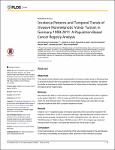Incidence Patterns and Temporal Trends of Invasive Nonmelanotic Vulvar Tumors in Germany 1999-2011. A Population-Based Cancer Registry Analysis
Buttmann-Schweiger, Nina
Klug, Stefanie J.
Luyten, Alexander
Holleczek, Bernd
Heitz, Florian
Bois, Andreas du
Kraywinkel, Klaus
Objectives: Time trends on the incidence and characteristics of invasive vulvar cancer in Germany have so far been studied in few local population- and hospital based tumor registries. We aimed to provide an overview on recent developments of vulvar cancer in Germany, using population-based cancer registry data. Methods: We analyzed the data on vulvar cancer of eight population-based German cancer registries for the period 1999-2011. ICD-10 codes and ICD-O-3 morphology codes were used to select site and histologic types. The annual percentage change was calculated on age-adjusted incidence rates with a joinpoint regression model. Results: A total of 12,711 registered cases of invasive carcinoma of the vulva were included in the analyses, hereof were 12,205 of squamous cell origin. Age-standardized incidence rates of vulvar cancer annually increased by 6.7% (95% confidence limits: 5.6-7.9) from 1.7 per 100,000 women in 1999 to 3.6 per 100,000 women in 2011. An increase was observed among women of all ages, and especially between 30 and 69 years of age. Conclusion: The annual incidence of invasive carcinoma of the vulva nearly doubled in the past decade in Germany, considerably exceeding the rates observed in other Western European countries. A combination of changes in risk factors, and documentation practice might have contributed to the observed substantial increase in vulvar cancer incidence.
No license information

